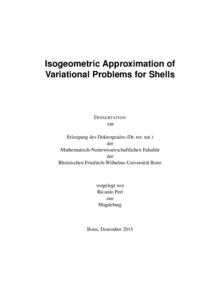Perl, Ricardo: Isogeometric Approximation of Variational Problems for Shells. - Bonn, 2016. - Dissertation, Rheinische Friedrich-Wilhelms-Universität Bonn.
Online-Ausgabe in bonndoc: https://nbn-resolving.org/urn:nbn:de:hbz:5n-43598
Online-Ausgabe in bonndoc: https://nbn-resolving.org/urn:nbn:de:hbz:5n-43598
@phdthesis{handle:20.500.11811/6767,
urn: https://nbn-resolving.org/urn:nbn:de:hbz:5n-43598,
author = {{Ricardo Perl}},
title = {Isogeometric Approximation of Variational Problems for Shells},
school = {Rheinische Friedrich-Wilhelms-Universität Bonn},
year = 2016,
month = may,
note = {The interaction of applied geometry and numerical simulation is a growing field in the interplay of com- puter graphics, computational mechanics and applied mathematics known as isogeometric analysis. In this thesis we apply and analyze Loop subdivision surfaces as isogeometric tool because they provide great flexibility in handling surfaces of arbitrary topology combined with higher order smoothness. Compared with finite element methods, isogeometric methods are known to require far less degrees of freedom for the modeling of complex surfaces but at the same time the assembly of the isogeo- metric matrices is much more time-consuming. Therefore, we implement the isogeometric subdivision method and analyze the experimental convergence behavior for different quadrature schemes. The mid-edge quadrature combines robustness and efficiency, where efficiency is additionally increased via lookup tables. For the first time, the lookup tables allow the simulation with control meshes of arbitrary closed connectivity without an initial subdivision step, i.e. triangles can have more than one vertex with valence different from six.
Geometric evolution problems have many applications in material sciences, surface processing and modeling, bio-mechanics, elasticity and physical simulations. These evolution problems are often based on the gradient flow of a geometric energy depending on first and second fundamental forms of the surface. The isogeometric approach allows a conforming higher order spatial discretization of these geometric evolutions. To overcome a time-error dominated scheme, we combine higher order space and time discretizations, where the time discretization based on implicit Runge-Kutta methods. We prove that the energy diminishes in every time-step in the fully discrete setting under mild time-step restrictions which is the crucial characteristic of a gradient flow. The overall setup allows for a general type of fourth-order energies. Among others, we perform experiments for Willmore flow with respect to different metrics.
In the last chapter of this thesis we apply the time-discrete geodesic calculus in shape space to the space of subdivision shells. By approximating the squared Riemannian distance by a suitable energy, this approach defines a discrete path energy for a consistent computation of geodesics, logarithm and exponential maps and parallel transport. As approximation we pick up an elastic shell energy, which measures the deformation of a shell by membrane and bending contributions of its mid-surface. Bézier curves are a fundamental tool in computer-aided geometric design. We extend these to the subdivision shell space by generalizing the de Casteljau algorithm. The evaluation of Bézier curves depends on all input data. To solve this problem, we introduce B-splines and cardinal splines in shape space by gluing together piecewise Bézier curves in a smooth way. We show examples of quadratic and cubic Bézier curves, quadratic and cubic B-splines as well as cardinal splines in subdivision shell space.},
url = {https://hdl.handle.net/20.500.11811/6767}
}
urn: https://nbn-resolving.org/urn:nbn:de:hbz:5n-43598,
author = {{Ricardo Perl}},
title = {Isogeometric Approximation of Variational Problems for Shells},
school = {Rheinische Friedrich-Wilhelms-Universität Bonn},
year = 2016,
month = may,
note = {The interaction of applied geometry and numerical simulation is a growing field in the interplay of com- puter graphics, computational mechanics and applied mathematics known as isogeometric analysis. In this thesis we apply and analyze Loop subdivision surfaces as isogeometric tool because they provide great flexibility in handling surfaces of arbitrary topology combined with higher order smoothness. Compared with finite element methods, isogeometric methods are known to require far less degrees of freedom for the modeling of complex surfaces but at the same time the assembly of the isogeo- metric matrices is much more time-consuming. Therefore, we implement the isogeometric subdivision method and analyze the experimental convergence behavior for different quadrature schemes. The mid-edge quadrature combines robustness and efficiency, where efficiency is additionally increased via lookup tables. For the first time, the lookup tables allow the simulation with control meshes of arbitrary closed connectivity without an initial subdivision step, i.e. triangles can have more than one vertex with valence different from six.
Geometric evolution problems have many applications in material sciences, surface processing and modeling, bio-mechanics, elasticity and physical simulations. These evolution problems are often based on the gradient flow of a geometric energy depending on first and second fundamental forms of the surface. The isogeometric approach allows a conforming higher order spatial discretization of these geometric evolutions. To overcome a time-error dominated scheme, we combine higher order space and time discretizations, where the time discretization based on implicit Runge-Kutta methods. We prove that the energy diminishes in every time-step in the fully discrete setting under mild time-step restrictions which is the crucial characteristic of a gradient flow. The overall setup allows for a general type of fourth-order energies. Among others, we perform experiments for Willmore flow with respect to different metrics.
In the last chapter of this thesis we apply the time-discrete geodesic calculus in shape space to the space of subdivision shells. By approximating the squared Riemannian distance by a suitable energy, this approach defines a discrete path energy for a consistent computation of geodesics, logarithm and exponential maps and parallel transport. As approximation we pick up an elastic shell energy, which measures the deformation of a shell by membrane and bending contributions of its mid-surface. Bézier curves are a fundamental tool in computer-aided geometric design. We extend these to the subdivision shell space by generalizing the de Casteljau algorithm. The evaluation of Bézier curves depends on all input data. To solve this problem, we introduce B-splines and cardinal splines in shape space by gluing together piecewise Bézier curves in a smooth way. We show examples of quadratic and cubic Bézier curves, quadratic and cubic B-splines as well as cardinal splines in subdivision shell space.},
url = {https://hdl.handle.net/20.500.11811/6767}
}






